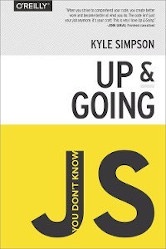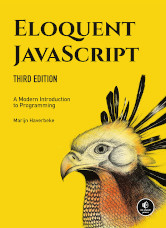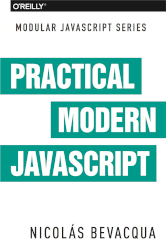Last Updated on February 14, 2025
JavaScript is possibly one of the easiest language to get up and running with. But to truly master the language requires a firm foundation of its intricacies. This compilation of free books ticks all the boxes.
JavaScript is an interpreted, prototype-based, scripting computer programming language. It came to popular attention as a simple client-side scripting tool, interacting with the user using forms and controlling the web browser, and remains a front-end language for web applications.
JavaScript features dynamic types, it is weakly typed, supports the structured programming syntax from C, uses prototypes instead of classes for inheritance, and copies many names and naming conventions from Java. It also borrows design principles from Scheme and Self, as well as concepts and syntax idioms such as C-style procedural roots.
1. You Don’t Know JS (book series) by Kyle Simpson

This 6 book set gets to grips with the core mechanisms of JavaScript. It’s a widely acclaimed series.
The book series is a firm favorite with beginners and intermediate programmers. The books go into some detail. There’s lots of good material whatever your proficiency in the language.
The content for these books derives heavily from a series of training materials.
Let’s take you through a brief summary of what each book offers.
Up & Going teaches you:
- Essential programming building blocks, including operators, types, variables, conditionals, loops, and functions.
- JavaScript’s core mechanisms such as values, function closures, this, and prototypes.
- Overview of other books in the series, and learn why it’s important to understand all parts of JavaScript.
Scope and Closures dives into trickier parts of the language.
- Learn about scope, a set of rules to help JavaScript engines locate variables in your code.
- Go deeper into nested scope, a series of containers for variables and functions.
- Explore function- and block-based scope, “hoisting”, and the patterns and benefits of scope-based hiding.
- Discover how to use closures for synchronous and asynchronous tasks, including the creation of JavaScript libraries.
this & Object Prototypes:
- Explore how the this binding points to objects based on how the function is called.
- Look into the nature of JS objects and why you’d need to point to them.
- Learn how developers use the mixin pattern to fake classes in JS.
- Examine how JS’s prototype mechanism forms links between objects.
- Learn how to move from class/inheritance design to behavior delegation.
- Understand how the OLOO (objects-linked-to-other-objects) coding style naturally implements behavior delegation.
Types & Grammar
- Get acquainted with JavaScript’s seven types: null, undefined, Boolean, number, string, object, and symbol
- Understand why JavaScript’s unique array, string, and number characteristics may delight or confound you.
- Learn how natives provide object wrappers around primitive values.
- Dive into the coercion controversy—and learn why this feature is useful in many cases.
- Explore various nuances in JavaScript syntax, involving statements, expressions, and other features.
Async & Performance
- Explore old and new JavaScript methods for handling asynchronous programming.
- Understand how callbacks let third parties control your program’s execution.
- Address the “inversion of control” issue with JavaScript Promises.
- Use generators to express async flow in a sequential, synchronous-looking fashion.
- Tackle program-level performance with Web Workers, SIMD, and asm.js.
- Learn valuable resources and techniques for benchmarking and tuning your expressions and statements.
ES6 & Beyond
- Learn new ES6 syntax that eases the pain points of common programming idioms.
- Organize code with iterators, generators, modules, and classes.
- Express async flow control with Promises combined with generators.
- Use collections to work more efficiently with data in structured ways.
- Leverage new API helpers, including Array, Object, Math, Number, and String.
- Extend your program’s capabilities through meta programming.
- Preview features likely coming to JS beyond ES6.
The 6 books are published under the Creative Commons Attribution-NonCommercial-NoDerivatives 4.0 International License.
The books are hosted at the project’s GitHub repository.
2. Eloquent JavaScript by Marijn Haverbeke

Eloquent JavaScript offers readers an illuminating introduction to the JavaScript programming language and programming in general.
Sections cover:
- Introduction.
- Basic JavaScript: values, variables, and control flow.
- Functions – an introduction to code that a program can go through whenever it wants. They can play the role of pure functions, algorithms, indirections, abstractions, decisions, modules, continuations, data structures, and more.
- Data structures: Objects and Arrays – at the same time as solving a few simple problems, this chapter discusses arrays and objects, and examines some related techniques.
- Bugs and Error Handling – strict mode, testing, debugging, error propagation, exceptions are explored.
- Functional Programming – produces abstraction through clever ways of combining functions.
- Searching – goes through the solution to two problems, discussing some interesting algorithms and techniques along the way.
- The Document Object Model.
- Regular Expressions – a way to describe patterns in string data. They form a small, separate language that is part of JavaScript and many other languages and tools.
- Modularity – deals with the process of organizing programs.
- Regular Expressions – a language for describing patterns in strings. They form a small, separate language, which is embedded inside JavaScript (and in various other programming languages).
- Web programming: A crash course – a quick, superficial introduction to the various elements that make the web work, and the way they relate to JavaScript.
- The Document-Object Model.
- Browser Events.
- HTTP requests.
The book has been translated into Bulgarian, Portuguese, and Russian.
This version is licensed under a Creative Commons attribution-noncommercial license. All code in this book may also be considered licensed under an MIT license.
Read the book. And there’s a paperback version to purchase.
3. Practical Modern JavaScript by Nicolás Bevacqua
 This book provides a highly practical look at ES6, without getting lost in the specification or its implementation details. Armed with practical examples, author Nicolás Bevacqua shows you new ways to deal with asynchronous flow control, declare objects or functions, and create proxies or unique sets, among many other features.
This book provides a highly practical look at ES6, without getting lost in the specification or its implementation details. Armed with practical examples, author Nicolás Bevacqua shows you new ways to deal with asynchronous flow control, declare objects or functions, and create proxies or unique sets, among many other features.
This book focuses on two aspects of JavaScript development: modularity and ES6 features. You’ll learn how to tackle application development by following a scale-out approach. As pieces of your codebase grow too big, you can break them up into smaller modules.
Chapters cover:
- ECMAScript and the Future of JavaScript.
- ES6 Essentials.
- Classes, Symbols, and Objects.
- Iteration and Flow Control.
- Leveraging ECMAScript Collections.
- Managing Property Access with Proxies.
- Built-in Improvements in ES6.
- JavaScript Modules.
- Practical Considerations.
To unlock the HTML, readers have to give permission for Pony Foo to use their Twitter account. We urge the author removes this unnecessary hurdle.
The book is published under the Creative Commons Attribution-NonCommercial-ShareAlike license.
Next page: Page 2 – JavaScript Enlightenment and more books
Pages in this article:
Page 1 – You Don’t Know JS (book series) and more books
Page 2 – JavaScript Enlightenment and more books
Page 3 – Developing Backbone.js Applications and more books
Page 4 – jQuery Fundamentals and more books
Page 5 – JavaScript Bible and more books
Page 6 – Object-Oriented JavaScript and more books
All books in this series:
| Free Programming Books | |
|---|---|
| Ada | ALGOL-like programming language, extended from Pascal and other languages |
| Agda | Dependently typed functional language based on intuitionistic Type Theory |
| Arduino | Inexpensive, flexible, open source microcontroller platform |
| Assembly | As close to writing machine code without writing in pure hexadecimal |
| Awk | Versatile language designed for pattern scanning and processing language |
| Bash | Shell and command language; popular both as a shell and a scripting language |
| BASIC | Beginner’s All-purpose Symbolic Instruction Code |
| C | General-purpose, procedural, portable, high-level language |
| C++ | General-purpose, portable, free-form, multi-paradigm language |
| C# | Combines the power and flexibility of C++ with the simplicity of Visual Basic |
| Clojure | Dialect of the Lisp programming language |
| ClojureScript | Compiler for Clojure that targets JavaScript |
| COBOL | Common Business-Oriented Language |
| CoffeeScript | Transcompiles into JavaScript inspired by Ruby, Python and Haskell |
| Coq | Dependently typed language similar to Agda, Idris, F* and others |
| Crystal | General-purpose, concurrent, multi-paradigm, object-oriented language |
| CSS | CSS (Cascading Style Sheets) specifies a web page’s appearance |
| D | General-purpose systems programming language with a C-like syntax |
| Dart | Client-optimized language for fast apps on multiple platforms |
| Dylan | Multi-paradigm language supporting functional and object-oriented coding |
| ECMAScript | Best known as the language embedded in web browsers |
| Eiffel | Object-oriented language designed by Bertrand Meyer |
| Elixir | Relatively new functional language running on the Erlang virtual machine |
| Erlang | General-purpose, concurrent, declarative, functional language |
| F# | Uses functional, imperative, and object-oriented programming methods |
| Factor | Dynamic stack-based programming language |
| Forth | Imperative stack-based programming language |
| Fortran | The first high-level language, using the first compiler |
| Go | Compiled, statically typed programming language |
| Groovy | Powerful, optionally typed and dynamic language |
| Haskell | Standardized, general-purpose, polymorphically, statically typed language |
| HTML | HyperText Markup Language |
| Icon | Wide variety of features for processing and presenting symbolic data |
| J | Array programming language based primarily on APL |
| Java | General-purpose, concurrent, class-based, object-oriented, high-level language |
| JavaScript | Interpreted, prototype-based, scripting language |
| Julia | High-level, high-performance language for technical computing |
| Kotlin | More modern version of Java |
| LabVIEW | Designed to enable domain experts to build power systems quickly |
| LaTeX | Professional document preparation system and document markup language |
| Lisp | Unique features - excellent to study programming constructs |
| Logo | Dialect of Lisp that features interactivity, modularity, extensibility |
| Lua | Designed as an embeddable scripting language |
| Markdown | Plain text formatting syntax designed to be easy-to-read and easy-to-write |
| Objective-C | Object-oriented language that adds Smalltalk-style messaging to C |
| OCaml | The main implementation of the Caml language |
| Pascal | Imperative and procedural language designed in the late 1960s |
| Perl | High-level, general-purpose, interpreted, scripting, dynamic language |
| PHP | PHP has been at the helm of the web for many years |
| PostScript | Interpreted, stack-based and Turing complete language |
| Prolog | A general purpose, declarative, logic programming language |
| PureScript | Small strongly, statically typed language compiling to JavaScript |
| Python | General-purpose, structured, powerful language |
| QML | Hierarchical declarative language for user interface layout - JSON-like syntax |
| R | De facto standard among statisticians and data analysts |
| Racket | General-purpose, object-oriented, multi-paradigm, functional language |
| Raku | Member of the Perl family of programming languages |
| Ruby | General purpose, scripting, structured, flexible, fully object-oriented language |
| Rust | Ideal for systems, embedded, and other performance critical code |
| Scala | Modern, object-functional, multi-paradigm, Java-based language |
| Scheme | A general-purpose, functional language descended from Lisp and Algol |
| Scratch | Visual programming language designed for 8-16 year-old children |
| SQL | Access and manipulate data held in a relational database management system |
| Standard ML | General-purpose functional language characterized as "Lisp with types" |
| Swift | Powerful and intuitive general-purpose programming language |
| Tcl | Dynamic language based on concepts of Lisp, C, and Unix shells |
| TeX | Markup and programming language - create professional quality typeset text |
| TypeScript | Strict syntactical superset of JavaScript adding optional static typing |
| Vala | Object-oriented language, syntactically similar to C# |
| VHDL | Hardware description language used in electronic design automation |
| VimL | Powerful scripting language of the Vim editor |
| XML | Rules for defining semantic tags describing structure ad meaning |

sorry 8- Link ????
All the links are working